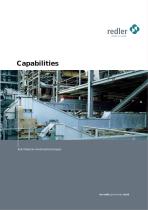
- Hydraulics - Pneumatics
- Filter and Separator
- Air separator
- Schenck Process Holding GmbH

- Company
- Products
- Catalogs
- News & Trends
- Exhibitions
Air separator Raymond®centrifugalfor bulk materials
Add to favorites
Compare this product
Characteristics
- Technology
- centrifugal, air
- Separated substance
- for bulk materials
Description
The Raymond® Mechanical Air Separator produces material with high uniform fineness; operates in open or closed circuit; can provide drying and cooling; is excellent for de-dusting and features the unique single or double whizzer for faster separation of fines and more positive rejection of oversize.
Single whizzer air separators
Single whizzer separators have only one row or bank of whizzer blades to set up centrifugal action. These units are ordinarily used for coarser separations up to approximately 85 to 90% passing 200 mesh (10-15% R74 microns) which is excellent for de-dusting and raw mix cement operations.
Double whizzer air separators
Double whizzer units have two rows or banks of whizzer blades. In normal operations they can produce finished materials up to 0.5-1% R44 microns 99 to 99.5% passing 325 mesh (0.5-1% R44 microns) and in finished cement circuits 2800 to 6000 Blaine or masonry cements.
Applications
Closed circuit grinding
When operated in closed circuit in combination with a pulverizer, the separator skims off the fines as fast as they are made so the mill works only on fresh material without wasting power. The tailings are discharged back to the mill for further reduction. The reground material is returned to the separator with the feed, so that a constant circulating load is set up between the mill and the separator.
The separator may be used in combination with ball mills, tube mills and compartment mills. Its function is to maintain a constant fineness in the finished product.
Open circuit
In some cases, it is convenient to install the separator independently from the mill to make both a fine and coarse product simultaneously.
Catalogs
*Prices are pre-tax. They exclude delivery charges and customs duties and do not include additional charges for installation or activation options. Prices are indicative only and may vary by country, with changes to the cost of raw materials and exchange rates.



